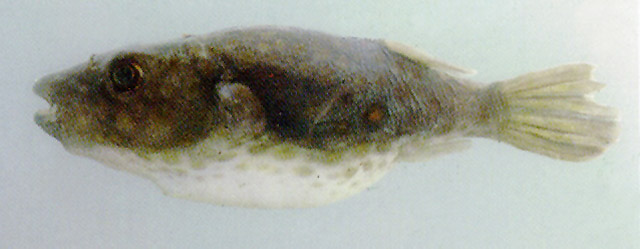| Tetraodontidae (Puffers), subfamily: Tetraodontinae |
| 16 cm (male/unsexed) |
|
demersal; freshwater; brackish; pH range: 7; dH range: 12 |
| Asia: Thailand to Indonesia. Found in the Mekong basin. |
|
Chin without marks or, rarely, with indistinct faint marks; upper part of body dirty brown, brownish gray or gray, poorly separated from lower part of body which tends to be dirty off-white, yellowish or pale gray, often with dusky mottling or spots; flank with one or more ocellated spots, which may be red-, green-, or blue centered. |
| Inhabits streams and rivers in upland and lowland areas (Ref. 56749). Occurs in flowing and standing water habitats (Ref. 12693). Also found in swamps and reservoirs, where it may be extremely abundant (Ref. 27661). Encountered in medium to large-sized rivers (Ref. 12975). Feeds on mollusks, crustaceans and other invertebrates as well as some plant matter and detritus (Ref. 12693). Possibly poisonous and not a commercial fish (Ref. 12693). Sometimes imported in the aquarium trade but known to be very aggressive and snappish (Ref. 12693). |
|
Least Concern (LC); Date assessed: 06 January 2020 Ref. (130435)
|
| harmless |
|
Found in Mekong, Bangpakong, Chao Phraya, Meklong, Tapi, Saiburi and Pattani basins and in Songkhla Lake (Ref. 27661). Museum: Mekong mainstream, CAS 79117 (near Chiang Khan); CAS 79123 (Huay Nam Ngam, 1 km downriver from That Phanom) (Ref. 5515); also from Nonthaburi, Chiang Mai, Phitsanulok, Tale Sap Songkhla, Hangkaben (Phra Nakhon Si Ayutthaya), Nong Khai,Khon Kaen, Kalasin, Pattani, Yala, Ubon Ratchathani, Kanchanaburi and Nakhon Sawan (Ref. 37773). Also Ref. 9648, 12693, 37773. In range Ref. 7050. |
Source and more info: www.fishbase.org. For personal, classroom, and other internal use only. Not for publication.

